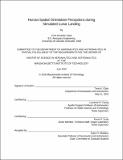| dc.contributor.advisor | Laurence R. Young and Kevin R. Duda. | en_US |
| dc.contributor.author | Clark, Torin Kristofer | en_US |
| dc.contributor.other | Massachusetts Institute of Technology. Dept. of Aeronautics and Astronautics. | en_US |
| dc.date.accessioned | 2010-10-29T13:50:04Z | |
| dc.date.available | 2010-10-29T13:50:04Z | |
| dc.date.copyright | 2010 | en_US |
| dc.date.issued | 2010 | en_US |
| dc.identifier.uri | http://hdl.handle.net/1721.1/59556 | |
| dc.description | Thesis (S.M.)--Massachusetts Institute of Technology, Dept. of Aeronautics and Astronautics, 2010. | en_US |
| dc.description | This electronic version was submitted by the student author. The certified thesis is available in the Institute Archives and Special Collections. | en_US |
| dc.description | Cataloged from student submitted PDF version of thesis. | en_US |
| dc.description | Includes bibliographical references (p. 119-123). | en_US |
| dc.description.abstract | During crewed lunar landings, astronauts are expected to guide a stable and controlled descent to a landing zone that is level and free of hazards by either making landing point (LP) redesignations or taking direct manual control. However, vestibular and visual sensorimotor limitations unique to lunar landing may interfere with landing performance and safety. Vehicle motion profiles of candidate lunar descent trajectories were used as inputs to a mathematical model for orientation system function, to predict human perception of orientation and identify disorientating illusions. Simulations were conducted using the vestibular-only portion of the model as well as incorporating the activation of visual cues. Dust blowback from the descent engine was modeled as well. The NASA Ames Vertical Motion Simulator was used to experimentally investigate human orientation perception during manually controlled landing trajectories. Subjects were tasked with reporting perceptions of vehicle tilt angle and horizontal velocity. There were three treatment conditions studied: eyes closed (blindfolded), eyes out the window on simulated lunar terrain, or eyes on display instruments. It was seen in the vestibular-only orientation perception model that the acceleration profile of the descent engine throughout candidate trajectories is likely to create a somatogravic illusion. This illusion creates the perception of being upright even when the actual vehicle orientation is significantly tilted. The model predicts the underestimation of tilt angle for the candidate automated trajectories as well during maneuvers resulting from LP redesignation and manual control maneuvers. The activation of visual pathways in the model improved orientation perceptions, however misperceptions persisted when visual cues were limited such as prior to the pitch-over maneuver and during dust blowback. Results from the motion base simulator experiment are in agreement with the likelihood of the somatogravic illusion occurring without the astronauts' continued focus on instrument displays. Horizontal velocity was poorly perceived without reliable visual cues, both in magnitude and direction. Misperception of spatial orientation is likely to increase workload and may reduce performance and safety during landing. Countermeasures should be designed to minimize the risk of astronaut disorientation, including the design of advanced displays. | en_US |
| dc.description.statementofresponsibility | by Torin Kristofer Clark. | en_US |
| dc.format.extent | 134 p. | en_US |
| dc.language.iso | eng | en_US |
| dc.publisher | Massachusetts Institute of Technology | en_US |
| dc.rights | M.I.T. theses are protected by
copyright. They may be viewed from this source for any purpose, but
reproduction or distribution in any format is prohibited without written
permission. See provided URL for inquiries about permission. | en_US |
| dc.rights.uri | http://dspace.mit.edu/handle/1721.1/7582 | en_US |
| dc.subject | Aeronautics and Astronautics. | en_US |
| dc.title | Human spatial orientation perceptions during simulated lunar landing | en_US |
| dc.type | Thesis | en_US |
| dc.description.degree | S.M. | en_US |
| dc.contributor.department | Massachusetts Institute of Technology. Department of Aeronautics and Astronautics | |
| dc.identifier.oclc | 668111650 | en_US |
